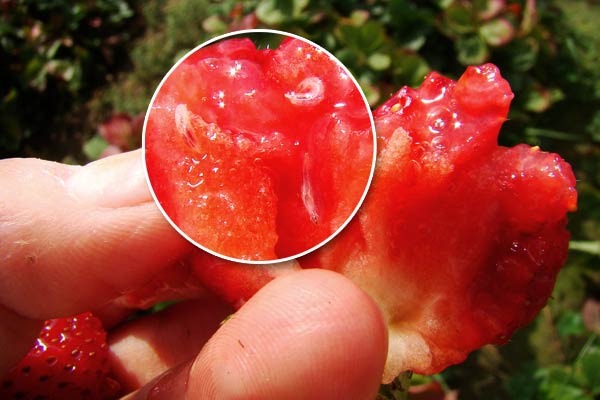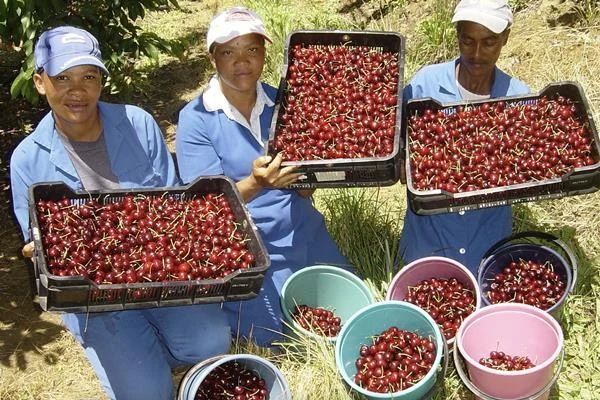The most significant progress in the improvement of rootstocks for sweet and sour cherry occurred around the turn of the century with the commercialization of the Gisela® series – interspecific hybrids of Prunus that provided early bearing, high productivity, and a wide range of vigor levels to grafted varieties (scion varieties).
This stimulated horticultural and physiological research, leading to innovations in sweet cherry orchard production systems, with improved yields, fruit quality, and labor efficiency.
This work led to the development of the Corette® series, ranging from dwarf to semi-dwarf, early and productive (Cass, Clare, Clinton, Crawford, Lake), and some less early semi-vigorous rootstocks (Lincoln, King).
Cherry rootstock improvement at MSU
Later, Amy Iezzoni, sour cherry breeder at Michigan State University, began evaluating dozens of sour cherry crosses and collecting germplasm with potential as cherry rootstocks.
Her work resulted in the development of the Corette® series, ranging from dwarf to semi-dwarf, early and productive (Cass, Clare, Clinton, Crawford, Lake), and some less early semi-vigorous rootstocks (Lincoln, King).
Sweet and sour cherry scions grafted on dwarf or semi-dwarf rootstocks show relative vigor levels that vary by site, based on results from NC140 project trials in North America.
Relative yields also varied depending on site and year due to the significant impact of extreme weather events in some areas.
In general, vigor and productivity levels are comparable to those of Gisela® 3 and Gisela® 5.
At several sites, suckering was excessive with Clare and notable with Cass and Lake, while generally minimal with Clinton and Crawford (similar to Gisela® 3 and 5).
However, at least three more years of trials and field observations are needed before concrete recommendations can be made for growers.
Genetic improvement of sweet (Prunus avium) and sour cherry (P. cerasus) rootstocks advanced significantly in the last decades of the 20th century, when the research group led by Professor Werner Gruppe at Justus Liebig University of Giessen (Germany) adopted a methodical approach to create a series of interspecific Prunus hybrids capable of providing different vigor levels (and other traits) to grafted varieties.
Early crosses and the Gisela® series
Until then, rootstock improvement was mostly limited to selecting seedlings or clones of P. avium, P. mahaleb, or P. cerasus, with slightly improved graft compatibility and/or soil adaptability, but with little or no vigor reduction or increase in earliness and productivity.
Early crosses involving a wide range of species included:
- P. avium × P. pseudocerasus → Colt
- P. avium × P. mahaleb → MxM series (Mahaleb × Mazzard)
Colt was initially thought to limit vigor, but under good irrigation (or frequent rain) it promotes vigorous growth similar to standard seedling rootstocks.
Later crosses with other Prunus species (e.g., from Gembloux University in Belgium) used P. canescens, P. dawyckensis, P. incisa, and P. serrula, producing weaker rootstocks (such as Inmil, Damil, and Camil).
New rootstock developments
Hanna Schmidt of the Giessen program created the commercial Gisela® rootstock series, ranging from dwarf (Gisela® 3) to semi-dwarf (Gisela® 5) and semi-vigorous (Gisela® 6 and 12).
The crosses released for commercial use derive from P. cerasus × P. canescens or vice versa. More recently released:
- Gisela® 13 – semi-vigorous
- Gisela® 17 – nearly vigorous
Gisela® 3, 5, and 6 performed very well in temperate climates in Europe and North America.
However, in hot and dry Mediterranean climates (California, Spain, Chile), they tend to show stress. Gisela® 12, 13, and 17 have adapted better with good irrigation management.
High-density orchard systems
The spread of Gisela® rootstocks stimulated significant innovations in sweet cherry orchard systems, providing material suited for high-density training systems and catalyzing studies in reproductive physiology that improved yields and fruit quality.
In the United States, between 1995 and 2020, sweet cherry production increased by 97%, and average productivity per acre by 31% (approx. 0.25 hectares; productivity increased by about 77%).
Genetic improvements in self-fertile varieties also contributed, but the availability of smaller, more efficient trees opened new opportunities for growers worldwide.
Other interspecific breeding programs include:
- Pillnitz program in East Germany (Brigitte Wolfram) → PiKu® rootstocks
- Russian program (Gennadiy Eremin) → Krymsk® rootstocks
The Krymsk® and Corette® rootstocks
Krymsk® rootstocks were selected in dry conditions and develop more extensive roots than Gisela®. They are less early but show better anchorage and growth in hot, dry conditions.
Krymsk® 5 can produce many suckers; Krymsk® 6 fewer but still more than Gisela®. Krymsk® 5 and 6 are hypersensitive to PDV and PNRSV viruses, so healthy material is recommended. Krymsk® 7 is a newer introduction, more vigorous, with fewer suckers and virus tolerance.
In the 1990s, Iezzoni began evaluating her sour cherry lines as rootstocks, leading to the Corette® series, recently launched for evaluation and potential commercialization.
The Corette® series from Michigan State University
Currently includes: Cass, Clare, Clinton, Crawford, Lake, Lincoln, and King, licensed to North American Plants (USA), Agromillora Group (EU, UK, South America), and Global Plant Variety Administration Ltd (New Zealand).
They are propagated via tissue culture and are compatible with sweet and sour cherry. They are tolerant to PDV and PNRSV viruses.
Genetic origin:
- Cass (Corette® 1) – Seed collected in Hungary (presumed natural hybrid of P. cerasus, P. avium and/or P. fruticosa)
- Clare (Corette® 2) – Same as above
- Clinton (Corette® 3) – O.P. seed from Gisela 5 (P. cerasus × P. canescens)
- Crawford (Corette® 4) – ‘Balaton’ × ‘Gisela 6’
- Lake (Corette® 5) – Seed collected in Hungary (presumed natural hybrid of P. avium and P. fruticosa)
- Lincoln (Corette® 6) – P. cerasus (‘English Morello’ × ‘Sumadinka’) × ‘Akastoi Korai’
- King (Corette® 7) – P. cerasus (‘English Morello’ × ‘Maliga Emléke’) × (P. cerasus, O.P. seed)
They were selected in early experiments at MSU, testing ‘Bing’, ‘Hedelfinger’, and ‘Montmorency’.
They have been tested in some trials in Michigan, Oregon, and Washington and in coordinated trials of the NC140 project (data collected for at least 10 years).
Some general conclusions:
- Cass, Clare, Clinton, Crawford, and Lake: dwarf (similar to Gisela® 3) to semi-dwarf (similar to Gisela® 5) vigor
- Lincoln and King: semi-vigorous (similar to Gisela® 6)
- Lake shows good drought stress tolerance
- In some sites, Clare and Cass produce many suckers, while Clinton and Crawford very few (like Gisela® 3 and 5)
- Yields and earliness in Cass, Clare, Clinton, Crawford, and Lake are good (equal to or better than Gisela® 5); Lincoln and King are less productive
The Weigi® series
After the Giessen program closed, some selections were transferred to Freising-Weihenstephan (Germany), from which the Weiroot® rootstocks were developed.
From this genetic base, Peter Stoppel developed three rootstocks for the USA:
- WeiGi® 1 (STO1) – P. cerasus O.P. (presumed P. avium)
- WeiGi® 2 (STO2) – P. cerasus × (P. avium × P. canescens)
- WeiGi® 3 (STO3) – P. cerasus × (P. avium × P. canescens)
Adapted to hot and dry conditions, but still pending large-scale testing in the USA.
- WeiGi® 1: semi-dwarf / semi-vigorous (similar to Gisela® 6)
- WeiGi® 2: dwarf / semi-dwarf (between Gisela® 3 and 5)
- WeiGi® 3: semi-vigorous (similar to Gisela® 12)
Traits described in the patents are not yet confirmed by U.S. trials.
A full range of vigor control
Genetic improvement of rootstocks has provided a full range of vigor, earliness, and productivity – key elements for efficient sweet cherry cultivation.
Prunus avium is naturally a vigorous forest species, not early bearing and with delicate fruit, unsuitable for mechanical harvest.
With smaller, more productive trees, intensive horticultural management is needed to balance leaf area and fruit load.
Early, dwarfing rootstocks have simplified training systems to achieve high yields of large, high-quality fruits.
Innovations such as Kym Green Bush (KGB) and Upright Fruiting Offshoots (UFO) have enabled simpler canopy architectures even with semi-vigorous rootstocks.
Future breeding programs must focus on:
- Earliness, productivity, different vigor levels
- Adaptation to specific soil conditions (e.g., high pH)
- Improved nutrient uptake efficiency (e.g., calcium)
- Resistance to climate stress (drought, high/low temperatures)
- Response to climate change and increasing extreme events
Source: Mundoagro
Image and cover credit: FGN
Greg Lang
Michigan State University, USA
Cherry Times - All rights reserved












